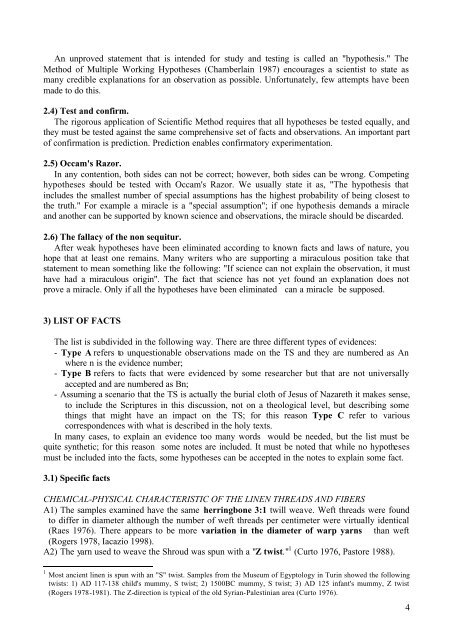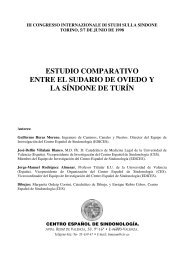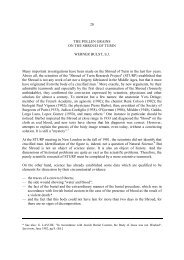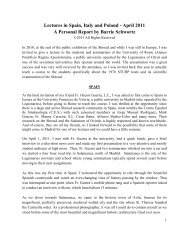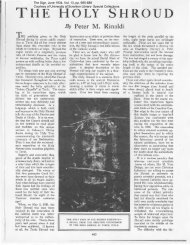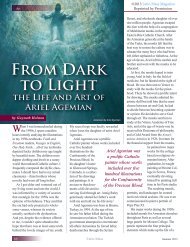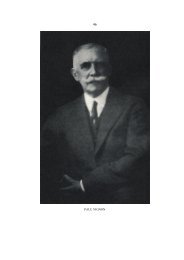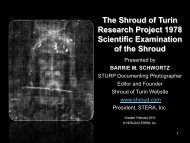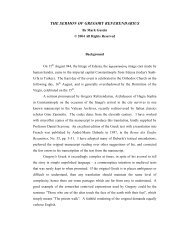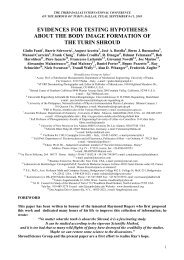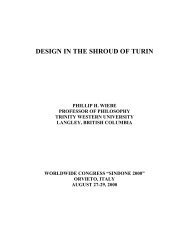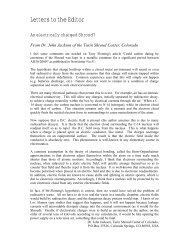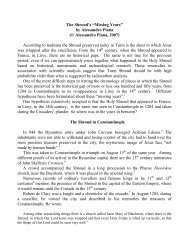list of evidences 10d Barrie - The Shroud of Turin Website
list of evidences 10d Barrie - The Shroud of Turin Website
list of evidences 10d Barrie - The Shroud of Turin Website
Create successful ePaper yourself
Turn your PDF publications into a flip-book with our unique Google optimized e-Paper software.
An unproved statement that is intended for study and testing is called an "hypothesis." <strong>The</strong>Method <strong>of</strong> Multiple Working Hypotheses (Chamberlain 1987) encourages a scientist to state asmany credible explanations for an observation as possible. Unfortunately, few attempts have beenmade to do this.2.4) Test and confirm.<strong>The</strong> rigorous application <strong>of</strong> Scientific Method requires that all hypotheses be tested equally, andthey must be tested against the same comprehensive set <strong>of</strong> facts and observations. An important part<strong>of</strong> confirmation is prediction. Prediction enables confirmatory experimentation.2.5) Occam's Razor.In any contention, both sides can not be correct; however, both sides can be wrong. Competinghypotheses should be tested with Occam's Razor. We usually state it as, "<strong>The</strong> hypothesis thatincludes the smallest number <strong>of</strong> special assumptions has the highest probability <strong>of</strong> being closest tothe truth." For example a miracle is a "special assumption"; if one hypothesis demands a miracleand another can be supported by known science and observations, the miracle should be discarded.2.6) <strong>The</strong> fallacy <strong>of</strong> the non sequitur.After weak hypotheses have been eliminated according to known facts and laws <strong>of</strong> nature, youhope that at least one remains. Many writers who are supporting a miraculous position take thatstatement to mean something like the following: "If science can not explain the observation, it musthave had a miraculous origin". <strong>The</strong> fact that science has not yet found an explanation does notprove a miracle. Only if all the hypotheses have been eliminated can a miracle be supposed.3) LIST OF FACTS<strong>The</strong> <strong>list</strong> is subdivided in the following way. <strong>The</strong>re are three different types <strong>of</strong> <strong>evidences</strong>:- Type A refers to unquestionable observations made on the TS and they are numbered as Anwhere n is the evidence number;- Type B refers to facts that were evidenced by some researcher but that are not universallyaccepted and are numbered as Bn;- Assuming a scenario that the TS is actually the burial cloth <strong>of</strong> Jesus <strong>of</strong> Nazareth it makes sense,to include the Scriptures in this discussion, not on a theological level, but describing somethings that might have an impact on the TS; for this reason Type C refer to variouscorrespondences with what is described in the holy texts.In many cases, to explain an evidence too many words would be needed, but the <strong>list</strong> must bequite synthetic; for this reason some notes are included. It must be noted that while no hypothesesmust be included into the facts, some hypotheses can be accepted in the notes to explain some fact.3.1) Specific factsCHEMICAL-PHYSICAL CHARACTERISTIC OF THE LINEN THREADS AND FIBERSA1) <strong>The</strong> samples examined have the same herringbone 3:1 twill weave. Weft threads were foundto differ in diameter although the number <strong>of</strong> weft threads per centimeter were virtually identical(Raes 1976). <strong>The</strong>re appears to be more variation in the diameter <strong>of</strong> warp yarns than weft(Rogers 1978, Iacazio 1998).A2) <strong>The</strong> yarn used to weave the <strong>Shroud</strong> was spun with a "Z twist." 1 (Curto 1976, Pastore 1988).1 Most ancient linen is spun with an "S" twist. Samples from the Museum <strong>of</strong> Egyptology in <strong>Turin</strong> showed the followingtwists: 1) AD 117-138 child's mummy, S twist; 2) 1500BC mummy, S twist; 3) AD 125 infant's mummy, Z twist(Rogers 1978-1981). <strong>The</strong> Z-direction is typical <strong>of</strong> the old Syrian-Palestinian area (Curto 1976).4


